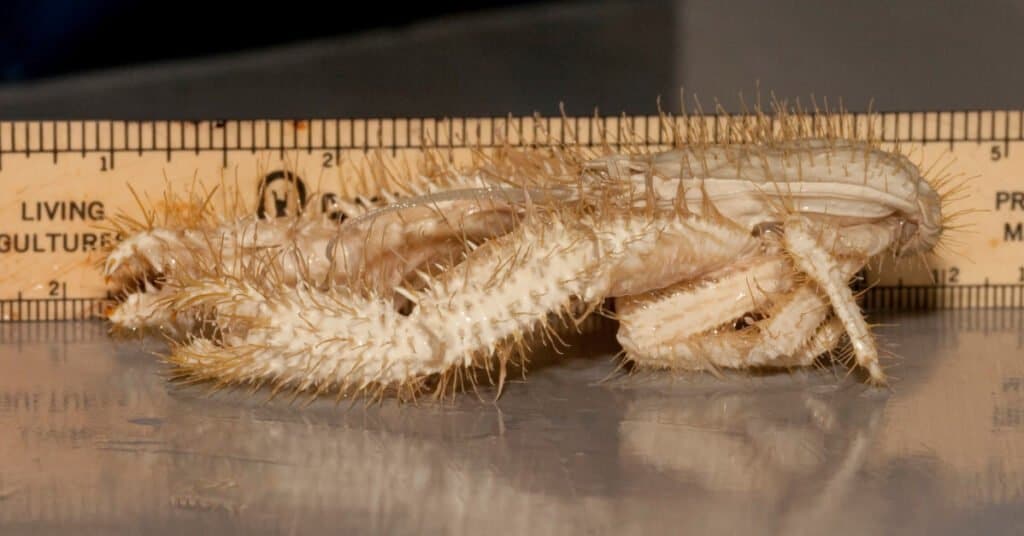Yeti Crab
.jumbotron {
background-image: url(“https://a-z-animals.com/media/2021/08/Yeti-crab-header-400×300.jpg”);
}
}
@media only screen and (min-width: 641px) and (max-width: 920px) {
.jumbotron {
background-image: url(“https://a-z-animals.com/media/2021/08/Yeti-crab-header-470×370.jpg”);
}
}
@media only screen and (min-width: 921px) {
.jumbotron {
background-image: url(“https://a-z-animals.com/media/2021/08/Yeti-crab-header.jpg”);
}
}
Yeti Crab
The yeti crab has hairy arms, which collect bacteria to feed on
Yeti Crab Scientific Classification
Read our Complete Guide to Classification of Animals.
Yeti Crab Conservation Status
Yeti Crab Facts
- Prey
- Bacteria
- Group Behavior
-
- Colony
- Fun Fact
- The yeti crab has hairy arms, which collect bacteria to feed on
- Estimated Population Size
- Unknown
- Most Distinctive Feature
- The white body and hairy claws
- Habitat
- Pacific Ocean
- Predators
- Fish and octopuses
- Diet
- Carnivore
- Type
- Crustacean
- Common Name
- Yeti Crab
- Number Of Species
- 4
This post may contain affiliate links to our partners like Chewy, Amazon, and others. Purchasing through these helps us further the A-Z Animals mission to educate about the world’s species..

Spiders that fly! Fish that walk! And 1000+ more incredible animals. Discover them all for FREE
.photo-gallery {
–margin: 0px auto 0px;
–padding: 0px 0px 0px 0px;
}
.gallery-link {
background-image: url(“https://a-z-animals.com/media/2021/08/Yeti-crab-on-black-1024×535.jpg”);
background-repeat: no-repeat;
background-size: cover;
background-position: center;
height: 500px;
justify-content: center;
text-align: center;
align-items: center;
display: flex;
border: 2px solid #000;
}
.gallery-link img {
height: 50%;
}
@media only screen and (max-width: 768px) {
.gallery-link {
height: 300px !important;
}
}
View all of the Yeti Crab images!
The yeti crab is a family of deep-sea decapods crustaceans (essentially, lobsters and crabs) with hairy arms and a white shell.
The very first species (Kiwa hirsuta) was only discovered in 2005 on a hydrothermal vent near Easter Island. Despite its reduced eyes and blindsight, the yeti crab nevertheless has several unique adaptations to survive the harsh biome of the cold and desolate deep seafloor. Because it can only be reached by deep-sea submarine, however, there is still a lot we don’t understand about it.
3 Incredible Yeti Crab Facts!
- One of the more interesting facts is that yeti crabs pile on top of each other to stay warm near hydrothermal vents. One scientist counted some 700 crabs per square meter.
- A genetic analysis suggests that the yeti crab family first evolved some 30 million years ago, when their ancestors first colonized hydrothermal vent biomes.
- Because it lives deep in the water, the yeti crab has no need of color pigments, making it appear white or gray.
Yeti Crab Classification and Scientific Name
The scientific name for the family of yeti crabs is Kiwa. It is named after the goddess of shellfish in Polynesian mythology. The yeti is not considered to be a member of the “true crabs,” but rather a closely related group called the squat lobsters, which includes the hermit crabs. More widely, they belong to the decapod order.
Yeti Crab Species
There are currently five recognized species of yeti crabs.
- Kiwa hirsuta: This is the first species discovered back in 2005 by a group of researchers from the Monterey Bay Aquarium. The crab was so different from any other decapod that it warranted an entirely separate family. The name hirsute is actually a Latin word meaning “hairy.”
- Kiwa puravida: A second species was discovered in 2006 near the waters of Costa Rica. It has the same hairy claws as Kiwa hirsute.
- Kiwa tyleri: First discovered in 2010, this species resides in the East Scotia Ridge, just north of Antarctica. It was jokingly named the Hoff crab, because its hairy chest resembled the actor David Hasselhoff. The conditions of its environment are so extreme that the temperature can drop some 400 degrees Celsius within just a few feet.
- Unnamed Species: A fourth unnamed species was first found in 2011 at a place called Longqi, or Dragon’s Breath, in the middle of the Indian Ocean. The claws of this species are comparatively quite short, and the hair is located on the chest like the Hoff crab. Based on a genetic analysis, they seem to be somewhat closely related to Kiwa tyleri. They last shared a common ancestor some 1.5 million years ago.
- Kiwa araonae: This species was first discovered in 2013 near the Australian-Antarctic Ridge. While it does have long claws, it also lacks the long, bristly hair.
Yeti Crab Appearance
The yeti crab is characterized by a generally crab-like shape (the hard shell, the long appendages, and big claws), but it also looks very much like the mythical snowman for which it was named. The defining features are the compact, all-white body, measuring about 6 inches long, and the long bristly claws that enable them to harvest bacteria. As mentioned previously, some have hairy chests in addition to or in place of the hairy claws. Because of its highly reduced eyes, it is thought to be completely or mostly blind.

Yeti Crab Distribution, Population, and Habitat
The yeti crab is largely endemic to the cold habitats of the southern Pacific Ocean region, adjoining the waters of the Antarctic. The hydrothermal vents near which they live are essentially cracks in the deep-sea floor where mineral-rich scalding hot water escapes from the surface of the earth. While they are highly adapted for this habitat, survival here requires a very careful balance. If they stray too far from the vents, then they can freeze to death in the frigid sea. But if they wander too close, then they can overheat and die.
The best-known yeti crab, Kiwa hirsuta, is presumed to be quite common near hydrothermal vents of the southern Pacific, but because there isn’t enough data available about them, the IUCN Red List has never assessed the conservation status for any of the five known species.
Yeti Crab Predators and Prey
Life near the hydrothermal vent is different from almost anywhere else on the planet. Organisms cannot rely on sunlight to capture energy, so they convert energy directly from the chemical flowing from the vents. The yeti crab’s role in this complex ecosystem is not yet fully understood, but we do know that it feeds on the bacteria flowing from the surface.
What eats the yeti crab?
The yeti crab does not seem to have many predators in its natural environment; it’s thought that some deep-sea octopuses and fish may find them quite edible.
What does the yeti crab eat?
The entire diet of these crabs revolves around bacteria. By waving their hairy claws through the plumes of oxygen, methane, and hydrogen sulfide emanating from the vents, they essentially harvest the bacteria to feed upon. To the human eye, this strange movement looks kind of like a rhythmic dance.
Yeti Crab Reproduction and Lifespan
The reproductive behavior and the lifespan of these crabs still remain a complete mystery. It’s believed that the hydrothermal vents are too warm for the larvae to develop, so the female probably lays eggs in the colder waters. Very few other facts are known.
Yeti Crab in Fishing and Cooking
Because of its remote environment, these crabs are not used in cooking or fishing. Since no one has tried to taste it, we don’t know how edible it is.
View all 15 animals that start with Y
Yeti Crab FAQs (Frequently Asked Questions)
What is the yeti crab?
The yeti crab is a blind deep-sea crab with reduced eyes and long bristles on its body. It lives near hydrothermal vents.
Can you eat yeti crab?
It isn’t known whether the yeti crab is very edible. Interest in it so far has been purely scientific and not culinary, so no one has ever tried to taste it. Presumably, it would taste like other crabs.
Is the yeti crab extinct?
Yeti crabs are actually thought to be fairly common wherever hydrothermal vents exist in the southern Pacific. While there isn’t yet enough data to determine the conservation status of these species, none of the five known types of yeti crabs are yet extinct.
Why does the yeti crab have fur?
The hairy claws have evolved to collect and harvest the crab’s main food, bacteria, flowing from the hydrothermal vents.
Where do yeti crabs live?
Most yeti crabs live around deep hydrothermal vents in the southern Pacific biome.
Are yeti crabs dangerous?
Yeti crabs pose no known danger to people. Because of their remote and extreme habitats, they will never be seen by people except in a deep-sea submarine.
What do yeti crabs eat?
Yeti crabs feast on bacteria.
Sources
- Ocean Conservancy, Available here: https://oceanconservancy.org/blog/2020/12/18/curious-yeti-crab/
- BBC Earth, Available here: http://www.bbc.com/earth/story/20170412-in-the-deep-sea-there-live-crabs-that-look-like-yetis
















